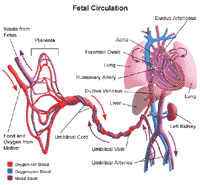Fetal Circulation
During pregnancy, the fetal circulatory system works differently than after birth:
- The fetus is connected by the umbilical cord to the placenta, the organ that develops and implants in the mother's uterus during pregnancy.
- Through the blood vessels in the umbilical cord, the fetus receives all the necessary nutrition, oxygen, and life support from the mother through the placenta.
- Waste products and carbon dioxide from the fetus are sent back through the umbilical cord and placenta to the mother's circulation to be eliminated.
 Click Image to Enlarge
Click Image to Enlarge
Blood from the mother enters the fetus through the vein in the umbilical cord. It goes to the liver and splits into three branches. The blood then reaches the inferior vena cava, a major vein connected to the heart.
Inside the fetal heart:
- Blood enters the right atrium, the chamber on the upper right side of the heart. Most of the blood flows to the left side through a special fetal opening between the left and right atria, called the foramen ovale.
- Blood then passes into the left ventricle (lower chamber of the heart) and then to the aorta, (the large artery coming from the heart).
- From the aorta, blood is sent to the head and upper extremities. After circulating there, the blood returns to the right atrium of the heart through the superior vena cava.
- About one-third of the blood entering the right atrium does not flow through the foramen ovale, but, instead, stays in the right side of the heart, eventually flowing into the pulmonary artery.
Because the placenta does the work of exchanging oxygen (O2) and carbon dioxide (CO2) through the mother's circulation, the fetal lungs are not used for breathing. Instead of blood flowing to the lungs to pick up oxygen and then flowing to the rest of the body, the fetal circulation shunts (bypasses) most of the blood away from the lungs. In the fetus, blood is shunted from the pulmonary artery to the aorta through a connecting blood vessel called the ductus arteriosus.
With the first breaths of air the baby takes at birth, the fetal circulation changes. A larger amount of blood is sent to the lungs to pick up oxygen.
- Because the ductus arteriosus (the normal connection between the aorta and the pulmonary valve) is no longer needed, it begins to wither and close off.
- The circulation in the lungs increases and more blood flows into the left atrium of the heart. This increased pressure causes the foramen ovale to close and blood circulates normally.
Click here to view the
Online Resources of Heart Center
|